Barrett M107A1 Semi Automatic .50 BMG Rifle, Tungsten Gray – 18067 For Sale
$12,867.00
The Barrett M107A1 Semi-Automatic .50 BMG Rifle in Tungsten Gray, Model 18067, is the result of over 35 years of meticulous research and feedback from elite military users, integrating significant enhancements while retaining the signature Barrett silhouette and reliability. Engineered with cutting-edge design and materials, the M107A1 is both lighter and stronger than its predecessors, featuring a 4-pound weight reduction for improved portability without sacrificing power. Optimized for use with sound suppressors, it offers a crucial reduction in signature, enhancing its stealth capabilities in modern warfare. Additional features such as a lightweight QD titanium bipod, suppressor-ready muzzle brake, bolt carrier group, and backup iron sights further enhance its stability, sound reduction, and targeting reliability. The M107A1 stands as a testament to precision engineering, designed to perform in the toughest environments.
What is the difference between M107A1 and M82A1?
The M107A1 and M82A1 are both .50 caliber sniper rifles developed by Barrett Firearms, commonly known for their long-range and anti-materiel capabilities. Here are some key differences between the two:
1. **Materials and Weight**:
– The M107A1 is constructed with more advanced materials, including a lightweight aluminum alloy, which reduces its overall weight compared to the M82A1. This makes the M107A1 more portable and easier to handle.
2. **Design Improvements**:
– The M107A1 has design enhancements such as a redesigned muzzle brake optimized for use with a suppressor, whereas the M82A1 typically features a traditional muzzle brake.
3. **Suppressor Compatibility**:
– The M107A1 is built to be more easily compatible with Barrett’s suppressors, facilitating quieter shooting and reducing recoil more effectively than the M82A1, which traditionally is not optimized with suppressor use in mind.
4. **Operational Features**:
– The M107A1 typically includes updated operational features such as improved ergonomics and a monopod feature integrated into the stock, offering better stability and shooting accuracy compared to the older M82A1 model.
Overall, while the M107A1 and M82A1 share similar roles and calibers, the M107A1 includes modernized features that enhance performance, reduce weight, and offer better adaptability to accessories like suppressors.
Can you legally own a Barrett 50 cal?
The legality of owning a Barrett .50 caliber rifle depends on several factors, including the country or state you are in and the specific laws and regulations in that jurisdiction. In the United States, for example, ownership of a Barrett .50 cal rifle is generally legal for civilians at the federal level, but state and local laws can vary significantly. Some states, like California, have restrictions or bans on .50 caliber rifles, while others might have specific requirements such as permits, registrations, or background checks.
It’s important to check the specific laws in your area and consult with legal experts or law enforcement if you are considering purchasing such a firearm. Always ensure that you comply with all applicable laws and regulations.
What is the range of the m107a1 sniper rifle?
The Barrett M107A1 sniper rifle has an effective range of approximately 1,800 meters (about 2,000 yards). However, the maximum range can extend beyond this under certain conditions.
Are Barrett rifles worth the money?
Barrett rifles are often considered worth the money for those who require high-performance, long-range precision rifles, such as military personnel, law enforcement, and long-range competitive shooters. They are renowned for their durability, accuracy, and power, particularly models like the Barrett M82 and M107, which are anti-materiel rifles capable of firing .50 BMG cartridges.
However, for recreational shooters or those with less demanding needs, the high price point may not be justifiable. It ultimately depends on the buyer’s specific needs, intended use, and budget constraints.
Is the 416 Barrett better than the 50 BMG?
The comparison between the .416 Barrett and the .50 BMG (Browning Machine Gun) depends on specific criteria and intended use:
1. **Ballistics and Performance**:
– The .416 Barrett is designed to offer superior ballistics at long ranges. It typically has a higher velocity and better retention of energy over extended distances, which can result in flatter trajectories and improved accuracy.
– The .50 BMG is well-known for its tremendous power and effectiveness at long ranges. It can carry more energy and has a larger projectile, making it highly effective for heavy-target penetration and stopping power.
2. **Applications**:
– The .416 Barrett is frequently favored in precision long-range shooting and military applications where accuracy at extreme distances is critical.
– The .50 BMG is often used in heavy machine guns and sniper rifles, offering immense power and versatility in anti-material roles.
3. **Recoil**:
– The .416 Barrett generally has less recoil compared to the .50 BMG, making it potentially easier to handle for some shooters.
4. **Cost and Availability**:
– Ammunition for the .50 BMG is typically more widely available and may be less expensive due to its long-standing use and production scale.
– The .416 Barrett, being a more specialized round, might be more expensive and less commonly found.
Ultimately, determining which is “better” depends on the specific needs and context. For someone seeking precise, long-range accuracy, the .416 Barrett might be more suitable. In contrast, the .50 BMG might be preferred for its power and versatility in a wider range of applications.
Is the M107 a sniper rifle?
Yes, the M107 is a sniper rifle. It is a variant of the Barrett .50 caliber sniper rifle series and is widely used by military forces for long-range shooting.
What states ban 50 cal rifles?
As of the latest information, only California has a statewide ban specifically targeting .50 caliber rifles. Additionally, some local jurisdictions, such as certain cities and counties, may have similar bans. It’s important to check both state and local laws for the most accurate and current regulations.
What does BMG stand for in guns?
In the context of guns, BMG stands for “Browning Machine Gun.” It is often associated with the .50 BMG cartridge, used in heavy machine guns and sniper rifles.
Can you hunt deer with a Barrett 50 cal?
Yes, you can hunt deer with a Barrett .50 cal rifle, but it is generally not recommended or practical for several reasons. The .50 caliber rifle is designed for long-range and heavy targets, and its power and large bullet size can cause excessive damage to a deer, which is not ethical for hunting. Additionally, the rifle’s weight, recoil, and cost make it an impractical choice for deer hunting compared to more conventional hunting rifles. It is also important to check local hunting regulations, as some areas may have restrictions on the caliber of firearms allowed for hunting certain game.
What sniper did Chris Kyle use?
Chris Kyle primarily used the McMillan TAC-338 sniper rifle during his service as a Navy SEAL sniper. He was also known to use other rifles, such as the MK 12 Designated Marksman Rifle and the .300 Winchester Magnum sniper rifle.
What sniper rifle is used by secret service?
The United States Secret Service employs several firearms, but for sniper operations, they have used rifles such as the Remington Model 700 and the Heckler & Koch HK417. Specific details about the current equipment used can vary and may not always be publicly disclosed for security reasons.
What is the best sniper rifle in the world?
Determining the “best” sniper rifle in the world is subjective and depends on various factors such as intended use, range, accuracy, reliability, and personal preference. However, some of the most highly regarded sniper rifles include:
1. **Barrett M82/M107**: Known for its long-range capabilities and powerful .50 BMG round, it’s widely used by militaries around the world.
2. **Accuracy International AWM**: Chambered in .300 Winchester Magnum or .338 Lapua Magnum, it’s known for its precision and effectiveness at long ranges.
3. **CheyTac M200 Intervention**: Famous for long-range accuracy, often utilized for extreme long-distance targeting.
4. **Sako TRG**: Renowned for its accuracy and versatility, often used by military and law enforcement snipers.
5. **Remington MSR**: A modular system known for adaptability and high accuracy over long distances.
Each of these rifles excels in particular scenarios, so the best choice may vary based on specific requirements and conditions.
What is the difference between 50 cal and 50bmg?
The term “50 cal” typically refers to the caliber of a firearm or ammunition, specifically a bullet that is .50 inches in diameter. However, it’s often used informally to refer to .50 BMG (Browning Machine Gun), which is a specific cartridge.
The .50 BMG is a cartridge developed for military use in the early 20th century for the M2 Browning machine gun. It is a specific type of .50 caliber round known for its large size and high power, often used in heavy machine guns, sniper rifles, and anti-materiel rifles.
In summary, “50 cal” is a more general term indicating the size (caliber) of the bullet, while “.50 BMG” refers to a specific type of cartridge with particular dimensions and specifications used for specific high-power firearms.
What is the difference between the Barrett M95 and M107?
The Barrett M95 and M107 are both high-caliber sniper rifles, but they have several differences:
1. **Design and Purpose**:
– **M95**: This is a bolt-action sniper rifle. It is designed for simplicity and reliability and is often used for long-range precision shooting.
– **M107**: This is a semi-automatic sniper rifle. It allows for quicker follow-up shots, making it suitable for different tactical scenarios, including anti-material purposes.
2. **Caliber**:
– Both the M95 and M107 are chambered in .50 BMG (12.7×99mm NATO), making them capable of long-range target engagement and penetrating heavy armor.
3. **Action Type**:
– **M95**: Bolt-action, which generally results in greater mechanical accuracy and reliability in adverse conditions.
– **M107**: Semi-automatic, which provides a higher rate of fire.
4. **Weight and Size**:
– **M95**: Being a bolt-action rifle, it is generally lighter and more compact than the M107.
– **M107**: It is heavier due to the semi-automatic action and its design to absorb recoil better, which also makes it bulkier.
5. **Usage and Role**:
– **M95**: Primarily used for long-range precision targeting with fewer shots. It is often preferred for its simplicity and fewer moving parts.
– **M107**: Offers versatility in mission profiles, capable of engaging multiple targets quickly with sustained firepower.
These differences make each rifle suited to specific types of missions and user preferences.
What is the speed of the Barrett M107A1 bullet?
The Barrett M107A1 fires a .50 BMG (Browning Machine Gun) cartridge, and the bullet’s muzzle velocity is typically around 2,800 to 2,900 feet per second (approximately 853 to 884 meters per second), depending on the specific ammunition used.
| Product Line | M107 |
|---|---|
| Action | Semi-Auto |
| Overall Length | 56.8" |
| Magazines Included | 1 |
Be the first to review “Barrett M107A1 Semi Automatic .50 BMG Rifle, Tungsten Gray – 18067” Cancel reply
Related products
Barrett M107A1
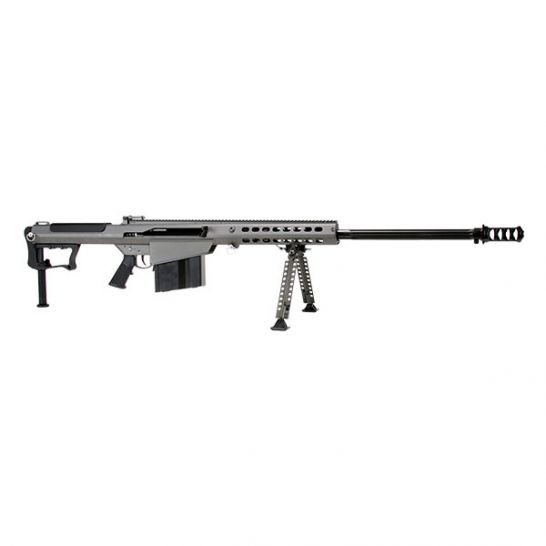
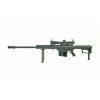
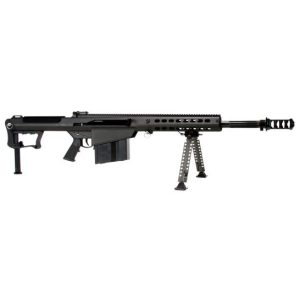
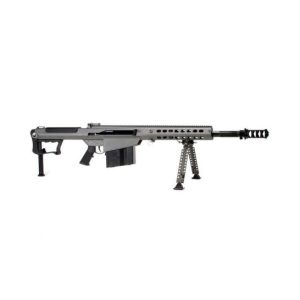
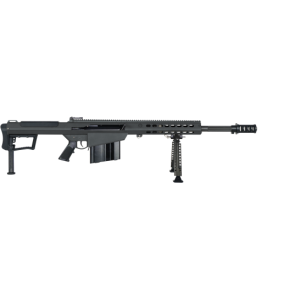
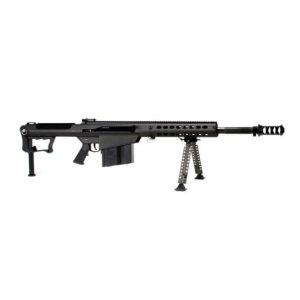
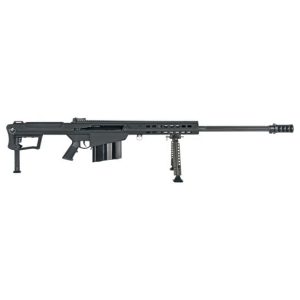
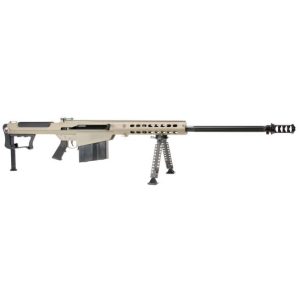
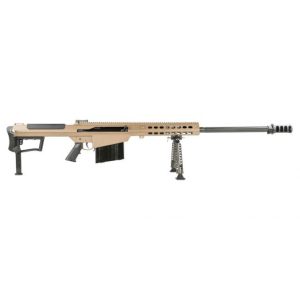
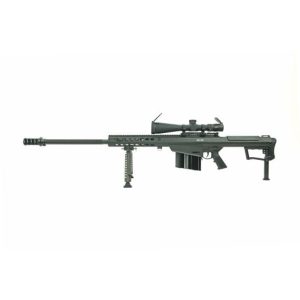
Reviews
There are no reviews yet.